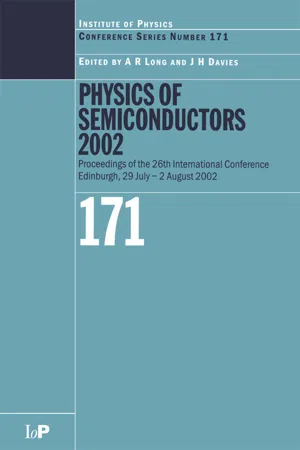
Physics of Semiconductors 2002
Proceedings of the 26th International Conference, Edinburgh, 29 July to 2 August 2002
- 313 pages
- English
- PDF
- Available on iOS & Android
Physics of Semiconductors 2002
Proceedings of the 26th International Conference, Edinburgh, 29 July to 2 August 2002
About This Book
The 26th International Conference on the Physics of Semiconductors was held from 29 July to 2 August 2002 at the Edinburgh International Conference Centre. It is the premier meeting in the field of semiconductor physics and attracted over 1000 participants from leading academic, governmental and industrial institutions in some 50 countries around the world. Plenary and invited papers (34) have been printed in the paper volume, and all submitted papers (742) are included on the downloadable resources.These proceedings provide an international perspective on the latest research and a review of recent developments in semiconductor physics. Topics range from growth and properties of bulk semiconductors to the optical and transport properties of semiconductor nanostructures. There are 742 papers, mostly arranged in chapters on Bulk, dynamics, defects and impurities, growth (147); Heterostructures, quantum wells, superlattices - optical (138); Heterostructures, quantum wells, superlattices - transport (97); Quantum nanostructures - optical (120); Quantum nanostructures - transport (85); New materials and concepts (52); Novel devices (43); and Spin and magnetic effects (48). A number of trends were identified in setting up the overall programme of the conference. There were significant contributions from new directions of research such as nanostructures and one-dimensional physics; spin effects and ferromagnetism; and terahertz and subband physics. These complemented areas in which the conference has traditional strengths, such as defects and bulk materials; crystal growth; quantum transport; and optical properties.As a record of a conference that covers the whole range of semiconductor physics, this book is an essential reference for researchers working on semiconductor physics, device physics, materials science, chemistry, and electronic and electrical engineering.
Frequently asked questions
Table of contents
- Cover
- Half Title
- Title Page
- Copyright Page
- Review
- Contents
- Supplementary Resources Disclaimer
- Section 1: Plenary papers
- Section 2: Invited papers—Bulk, dynamics, defects and impurities, growth
- Section 3: Heterostructures, quantum wells, superlattices— optical
- Section 4: Heterostructures, quantum wells, superlattices—transport
- Section 5: Quantum nanostructures—optical
- Section 6: Quantum nanostructures—transport
- Section 7: New materials and concepts
- Section 8: Novel devices
- Section 9: Spin and magnetic effects
- Author index